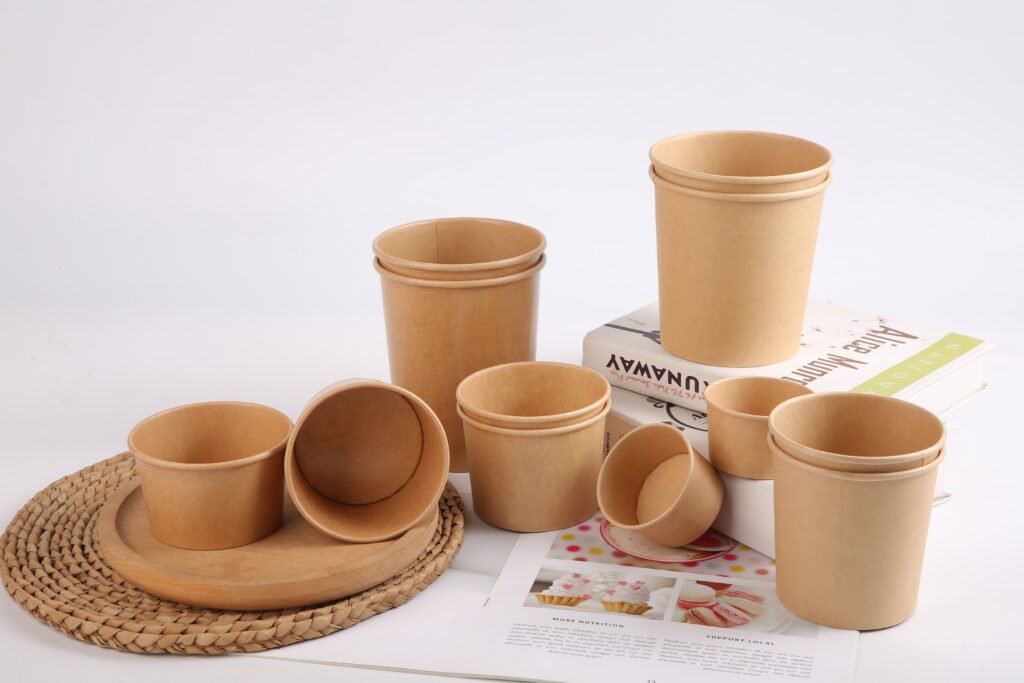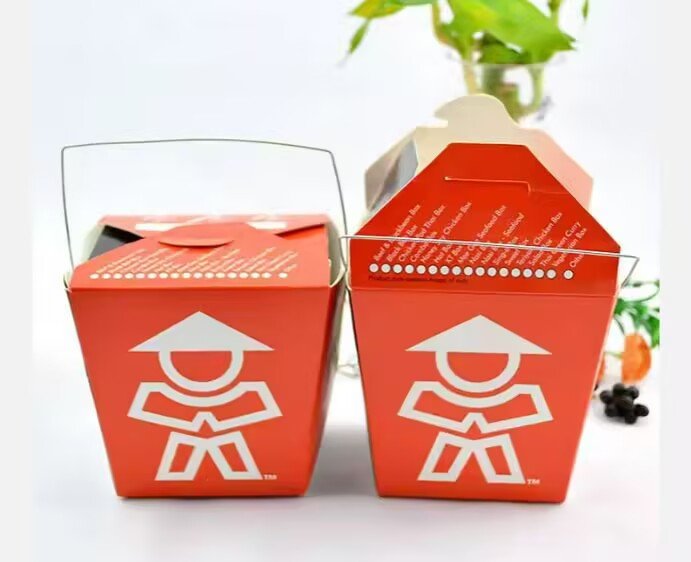European supermarket plastic ban and 2025 solution (19)
Ganyuan
2025 年 6 月 23 日

The value reconfiguration of dip paper cups in the global food and beverage supply chain
Chen Qiming, a fried chicken stall owner in Bangkok’s Chinatown, has been in the business for twelve years and never imagined that the small paper cups used for sauces would become a turning point in his business. Last year, during the rainy season, poor-quality paper cups caused customers to complain about sauce leakage, leading to fines from food delivery platforms, resulting in a monthly loss of over 3,000 RMB. After accidentally trying a leak-proof dipping cup with reinforced ribs at the bottom, he conducted a simple test: filling it with thick peanut butter and placing it upside down for one minute, no leakage was observed at the cup’s rim; when placed on the damp night market stone slabs, the cup remained stable. Surprisingly, several Korean tourists even took photos of the dipping cup and asked about its purchase channel. Three months later, Chen Qiming had expanded his business to wholesale seven surrounding stalls, with monthly commission income exceeding 25,000 RMB. This case highlights the hidden value of dipping paper cups in the international catering market —— they are not just containers but also a commercial lever that reduces operational risks and enhances brand image.

At the popular fried chicken restaurant ‘Chicken Plus’ in Seoul’s Hongda area, over 600 of these 5 cm wide and 3 cm tall cups are consumed daily. The key to their success lies in their precise adaptation to various usage scenarios: the wide base design significantly reduces the risk of spilling when dipping into French fries; the double-layer food-grade coating on the cup walls ensures they remain crisp even after being exposed to 85℃ hot oil for 30 minutes; and the laser-cut cup rim ensures a comfortable feel with no rough edges. Meanwhile, a trendy seafood stall at Bangkok’s Train Night Market introduced a three-compartment cup that holds sweet and sour sauce, garlic sauce, and lime juice, attracting over 200 stall owners to purchase in bulk each month. The German chain restaurant ‘Schnitzel Haus’ has also achieved a 40% increase in service efficiency by designing a convertible cup lid that can be flipped into a non-slip base, allowing waiters to serve eight cups of sauce with one hand. These innovations are the result of manufacturers’ deep insights and precise responses to global dining trends.
The transformation of Lin Huijuan, a trader from Yiwu, Zhejiang, is particularly enlightening. In early 2023, the dipping cups produced by a Vietnamese factory she represented faced a collective lawsuit due to leakage issues. Upon analyzing the cost structure, she discovered that the low-quality cups, priced at 0.08 yuan each, had a comprehensive cost of 0.11 yuan (including a 30% compensation for damage). In contrast, leak-proof cups, priced at 0.12 yuan, could be resold for 0.35 yuan due to their zero-leak feature. Lin Huijuan promptly adjusted her strategy: she first required new suppliers to provide test boxes pre-filled with peanut butter, coconut milk, and hot chili oil, and conducted an inverted challenge at the customer’s office. She then established a tiered pricing system, emphasizing to small restaurants that’ the extra 4 cents per cup can save 20 cents in compensation, ‘and to chain brands, she promised’ an order price of 0.25 yuan for orders of 100,000 cups or more. ‘Finally, she addressed procurement concerns with the promise of’ a 30,000 trial order with a seven-day turnaround, and priority restocking upon sale out.’ After implementing this strategy for three months, her net profit increased by 28,000 yuan per month.
The lesson from Nguyen Van Hung, a wholesaler in Ho Chi Minh City, Vietnam, is a cautionary tale for the industry. In 2022, due to the procurement of unverified dipping cups, his shipment to France was found to contain excessive levels of fluorescent agents during customs inspection, resulting in the destruction of the entire container and direct losses of 120,000 yuan. Following this incident, he implemented a three-tier risk control system: First, factory video records of three extreme tests are required —— the peanut butter must not penetrate after being inverted for 60 minutes, remain unchanged under a 3-kilogram load after boiling water immersion, and withstand cold transport at-5°C; Second, during the packing process, the fit of the bottom reinforcement ring is strictly monitored to ensure each box passes the carton insertion test and the stepping test; Third, upon first contact with suppliers, they are required to provide the FDA certificate number and the official website link for the LFGB test report, and a third-party institution is commissioned to verify the validity of the certificate. Over the past two years, this system has maintained a zero customer complaint rate.
For newcomers, Malaysian intermediary Chen Jiaxin’s ice-breaking strategy was ingenious. She first ordered a test set from the factory, which included three types of cups—short and fat, three-tier, and stand-up—and six categories of sauces (ranging from acidic lemon juice to oily sesame paste). When visiting a fried chicken shop owner in Kuala Lumpur, she conducted a spot test: the leak-proof cup remained free of oil stains after five minutes of being inverted with a tissue, whereas ordinary cups sold on the market showed signs of oil stains after just three minutes. She then presented a detailed calculation model: “Given your average daily consumption of four hundred cups, the monthly cost for inferior cups, including compensation, is approximately 2160 Malaysian Ringgit (MYR), while leak-proof cups cost only 1440 MYR and carry no claim risk, resulting in an additional monthly income of 720 MYR.” This visual argument helped her secure five annual contracts within two weeks.
The technological advancements in the dip sauce cup manufacturing industry are driving a transformation in the global supply chain. Leading companies have achieved dual guarantees through innovations in lamination technology: the inner water-based anti-oil coating meets EU AP (2004) 5 standards, while the outer PE film ensures the cup remains intact even when frozen at-18°C. The cup’s bottom reinforcement, achieved through molding technology, increases its load-bearing capacity to three kilograms. More importantly, an environmental breakthrough has been made: —— using sugarcane pulp-based lamination reduces the degradation cycle from 300 years for traditional PE lamination to just six months. These technological advancements have reduced the cost premium of leak-proof dip sauce cups from 40% in 2021 to 12% in 2024, significantly alleviating buyers’ cost concerns.
The international market is increasingly stringent in its certification requirements for dipping sauce cups. The EU’s PPWR regulation, set to take effect in 2025, mandates that all food contact packaging must provide a full ingredient list. The US FDA has tightened its detection limit for fluorescent agent migration to 0.01ppm, and Japan’s JFSL standard now includes mandatory screening for phthalates. Forward-thinking manufacturers have established a comprehensive certification matrix, which includes not only the basic FDA/LFGB/FSC certifications but also BRCGS packaging certification, ISO14067 carbon footprint reporting, and TUV compostability certification. These certifications serve as market entry passes and provide intermediaries with a premium negotiation advantage —— products with full certification can see their international procurement bids increase by up to 15%.
The future of the dipping sauce paper cup industry will be driven by scenario innovation. The popular tearable edge dipping sauce cups in Tokyo izakayas transform the cup rim into a sauce tray with pre-set tear lines; the edible cups introduced by Los Angeles health restaurants are fully biodegradable thanks to their seaweed-based coating; and the smart temperature cups showcased at the Seoul Coffee Expo display the real-time temperature of the sauce using heat-sensitive ink. These innovations reflect the global food industry’s triple pursuit of safety, environmental friendliness, and functionality. For Chinese manufacturers, the key is to be the first to convert laboratory technology into commercial solutions, thereby controlling this billion-dollar international market.
Recent News




